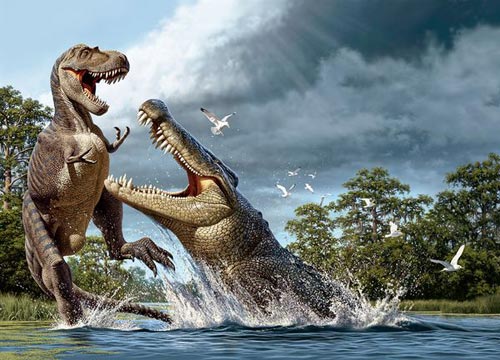Crocodile eat dinosaur meat
Hard feces like rock and strange bony bones help scientists reconstruct a 9m long prehistoric reptile: crocodile eating dinosaur meat.
Deinosuchus species (meaning terrible crocodile) often hang around in shallow water and hunt dinosaurs of the same size as themselves.
Last week, paleontologists announced the conclusion after analyzing debris from the 79 million-year fossil heap. This is the first pile of deinosuchus that humans find. This giant crocodile proclaims a large area of land now known as the United States and northern Mexico.
Sand and other types of animal shells in the fossil heap (found near a stream in the state of Georgia in the US) show that giant crocodiles love to live in estuaries and eat sea turtles.
Researchers at Columbus University also found a fossil shark tooth in the outer layer of the crocodile pile. Because the tooth showed no signs of digestion, the team thought that the shark had left the tooth after searching for food in the dung.
In the dung pile, the researchers found no bones or other parts that were not digested by the prey. 'Both ancient crocodiles and today have gastric juice that can digest bones, horns, teeth and the like,' explains Samantha Harrell.

Return to dinosaurs
After studying the mark of Deinosuchus's teeth left on prey bones, palaeontologist David Schwimmer concluded that, in the past, there was the battle of death between the crocodile about 9m long with dinosaurs of the same size, including relatives of the tyrant dinosaur (T-rex) are Appalachiosaurus montgomeriensis and Albertosaurus.
'Research on the bone segment with the bite shows that the bone is healing. This means that the dinosaurs were bitten but escaped death. This proves that crocodiles have hunted live rather than eating corpses , 'Schwimmer said.
First, the Schwimmer observed rippling egg-chipping spots in sea turtle fossils found in Georgia. Later, he saw similar traces in dinosaur bones in Big Bend National Park (Texas State) and New Jersey State Museum.
'I find these bites come from really healthy teeth with many teeth. And it is clear that the giant crocodile teeth are the author. There is nothing else that can create this kind of blunt tooth mark ' , Schwimmer said.
However, the teeth marks only reveal part of the picture. 'Modern crocodiles have the ability to swallow small prey and tear big prey into pieces and eat, so the trace is very rare. We can deduce that a giant animal like Deinosuchus must have a much more terrible eating habit , 'said the expert on the crocodile bite at the University of Iowa.
Extinct for lack of food?
The mark of the bite of dinosaurs is real but why the more crocodiles that feed on dinosaurs, the more likely they are to hunt down the bones of small turtles?
Modern crocodiles hunt many animals and eat whatever is available in their territory. This may be true for prehistoric crocodiles, Drumheller said.
Giant reptiles similar to Deinosuchus in North America are also found in other lands and at different times, palaeontologist Paul Sereno of the University of Chicago said. He found the fossil Sarcosuchus species (also known as SuperCroc - 110 million years) in Niger (a West African country).
'We have two species - Deinosuchus and SuperCroc - with different ages. This proves that the body of the crocodile grows to a gigantic size, the size of a dinosaur, 'said an explorer named Sereno who works for the National Geographic Society (USA).
Deinosuchus lived just before the Cretaceous ended. They are closer to modern crocodiles than SuperCroc. What happened to these two prehistoric sea monsters?
Adult male crocodiles may have to cross many miles in the estuary area to get enough food. The territory for each individual cannot be large, so the number of giant crocodiles cannot be crowded. This makes them vulnerable to extinction in difficult times, Sereno explained.
- Jura crocodile sharp teeth like tyrants
- Which meat is the best dinosaur?
- What flavor does the dinosaur meat taste good or not?
- Ancient mangoes weigh more than a ton of crocodile meat
- Animals push back dinosaurs to eat meat with a tail
- What did the old dinosaur eat? It turns out their menu is
- Lolong crocodile made 'Ambassador' for conservation program
- Video: 4m long crocodile devoured its kind
- Video: Crocodile expert holds a giant crocodile stick and the end
- Video: Crocodile all jump straight up
- 6m long crocodile fish bait in Australia
- What do you know about 'vegetarian' meat?
 Discovered an ancient centipede fossil 99 million years old
Discovered an ancient centipede fossil 99 million years old Discovered bat-like dinosaurs in China
Discovered bat-like dinosaurs in China Discovered a 200-year-old bronze cannon of the coast
Discovered a 200-year-old bronze cannon of the coast Discover 305 million-year-old spider fossils
Discover 305 million-year-old spider fossils Blind leopard fights with crocodiles over antelope carcass
Blind leopard fights with crocodiles over antelope carcass  Crocodile collides with sharks right on the beach
Crocodile collides with sharks right on the beach  How rare are albino crocodiles?
How rare are albino crocodiles?  100 million years ago, the Sahara Desert was inhabited by crocodiles that could run like athletes
100 million years ago, the Sahara Desert was inhabited by crocodiles that could run like athletes  Video of thousands of crocodiles basking on the riverbank attracts more than 10 million views
Video of thousands of crocodiles basking on the riverbank attracts more than 10 million views  Meteors made dinosaurs extinct, why are crocodiles still alive?
Meteors made dinosaurs extinct, why are crocodiles still alive? 